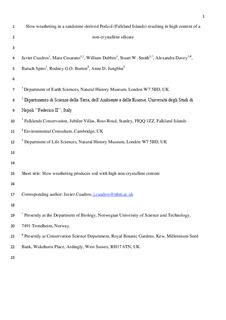| dc.description.abstract | Mineral weathering processes in soils are important controls on soil characteristics and on bio-and geochemical cycling. Elucidation of these processes and their mechanisms is crucial for understanding soil environments and their influence globally. An Umbric Podzol from the Falkland Islands was studied while investigating possible ways to counteract soil degradation and loss. The soil had lost the O, E and Bs horizons through erosion, thus revealing the transitional B/C horizon, which grades into the underlying parent material. Samples were taken from the B/C surface and 5 cm below the surface, then analyzed with X-ray diffraction, scanning electron microscopy with energy-dispersive X-ray spectroscopy, organic C and N analysis, analysis of extractable Fe and Al with the dithionite-citrate-bicarbonate and ammonium oxalate methods, and Fourier-transform infrared analysis. The soil fabric and mineralogy were compatible with derivation from sandstone rock. Clasts of heterogeneous mineral composition as well as loose material from disaggregated clasts were present. The soil had large proportions of quartz and albite, and minor amounts of muscovite, chlorite, plagioclase, feldspar, kaolinite, and non-diffracting Fe oxide (goethite and/or ferrihydrite). The most peculiar characteristic was a large component (~7 wt% of the bulk soil) of an amorphous (non-X-ray diffracting) silicate phase of small particle size (< 1 m), non extractable, with heterogeneous composition. The average composition of this phase is similar to that of the bulk soil and approaches that of Al-Fe-rich smectite. The amorphous phase is not allophane or imogolite by any of the analyses carried out. The amorphous silicate phase is formed partly by the translocation of metals from O, E and Bs horizons and partly by dissolution of the primary minerals of the B/C horizon, both of which precipitated in combination with low water mobility causing rapid saturation of the interstitial water. There are no reports of amorphous silicate phases with these characteristics or abundances from soils or other weathering environments. Thus, our observations indicate the existence of complex, successive weathering steps not yet identified that could be investigated in materials subjected to slow weathering such as the soil described here. | nb_NO |
